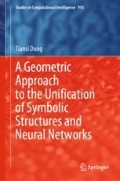Abstract
This chapter is the continued discussion on the last experiment in Chap. 6—Under what condition, can the precision for the Task of Membership-Validation reach 100%? We will create a new type of Geometric Connectionist Machines for Triple Classification task in Knowledge Graph reasoning. Our key question is: How shall we spatialize labeled tree structures onto vector embeddings?
A creature didn’t think in order to move; it just moved, and by moving it discovered the world that then formed the content of its thoughts.
— Larissa MacFarquhar “The mind-expanding ideas of Andy Clark” The New Yorker
Access this chapter
Tax calculation will be finalised at checkout
Purchases are for personal use only
Notes
- 1.
That is to say, suppose that (\(h, r, t_x\)) holds and \(t_x\) has a sibling \(t_0\) in the training dataset such that (\(h, r, t_0\)), we initialize the \(\mathscr {N}\)-Ball of \(t_x\) the way we initialize the \(\mathscr {N}\)-Ball of \(t_0\).
- 2.
- 3.
- 4.
References
Auer, S., Bizer, C., Lehmann, J., Kobilarov, G., Cyganiak, R., & Ives, Z. (2007). DBpedia: A nucleus for a web of open data. In K. Aberer, K.-S. Choi, N. Noy, D. Allemang, K.-I. Lee, L. Nixon, J. Golbeck, P. Mika, D. Maynard, R. Mizoguchi, G. Schreiber & P. Cudré-Mauroux (Eds.) ISWC07. Springer.
Bishop, C. M. (2006). Pattern recognition and machine learning. Secaucus, NJ, USA: Springer.
Bollacker, K., Evans, C., Paritosh, P., Sturge, T., & Taylor, J. (2008). Freebase: A collaboratively created graph database for structuring human knowledge. In SIGMOD ’08 (pp. 1247–1250) New York, NY, USA: ACM.
Bordes, A., Usunier, N., Garcia-Duran, A., Weston, J., & Yakhnenko, O. (2013). Translating embeddings for modelling multi-relational data. In C. J. C. Burges, L. Bottou, M. Welling, Z. Ghahramani, & K. Q. Weinberger (Eds.) Advances in Neural Information Processing Systems, 26, 2787–2795. Curran Associates, Inc.
Faruqui, M., Dodge, J., Jauhar, S. K., Dyer, C., Hovy, E., & Smith, N. A. (2015). Retrofitting word vectors to semantic lexicons. In Proceedings of the 2015 Conference of the North American Chapter of the Association for Computational Linguistics: Human Language Technologies (pp. 1606–1615). ACL.
Goodfellow, I., Bengio, Y., & Courville, A. (2016). Deep learning. The MIT Press.
Han, X., Liu, Z., & Sun, M. (2016). Joint representation learning of text and knowledge for knowledge graph completion. CoRR. abs/1611.04125.
He, S., Liu, K., Ji, G., & Zhao, J. (2015). Learning to represent knowledge graphs with gaussian embedding. In CIKM’15 (pp. 623–632). New York, USA: ACM.
Ji, G., He, S., Xu, L., Liu, K., & Zhao, J. (2015). Knowledge graph embedding via dynamic mapping matrix. In ACL’2015 (pp. 687–696). Beijing: ACL.
Manning, C. D., Raghavan, P., & Schütze, H. (2008b). Introduction to information retrieval. New York, NY, USA: Cambridge University Press.
Miller, G. A. (1995). Wordnet: A lexical database for english. Communications of the ACM, 38(11), 39–41.
Nickel, M., & Kiela, D. (2017). Poincaré embeddings for learning hierarchical representations. In I. Guyon, U. V. Luxburg, S. Bengio, H. Wallach, R. Fergus, S. Vishwanathan & R. Garnett (Eds.). Advances in Neural Information Processing Systems (Vol. 30, pp. 6338–6347). Curran Associates, Inc.
Socher, R., Chen, D., Manning, C. D., & Ng, A. (2013). Reasoning with neural tensor networks for knowledge base completion. In C. J. C. Burges, L. Bottou, M. Welling, Z. Ghahramani, & K. Q. Weinberger (Eds.) Advances in Neural Information Processing Systems, 26, 926–934. Curran Associates, Inc.
Speer, R., Chin, J., & Havasi, C. (2017). Conceptnet 5.5: An open multilingual graph of general knowledge. In Proceedings of the Thirty-First AAAI Conference on Artificial Intelligence, February 4–9, 2017, San Francisco, CA, USA (pp. 4444–4451).
Suchanek, F. M., Kasneci, G., & Weikum, G. (2007). Yago: A core of semantic knowledge. In WWW ’07 (pp 697–706). New York, NY, USA: ACM.
Wang, Z., & Li, J. (2016). Text-enhanced representation learning for knowledge graph. IJCAI, 1293–1299.
Wang, Z., Zhang, Feng, J., & Chen, Z. (2014a). Knowledge graph and text jointly embedding. In EMNLP, 1591–1601.
Xiao, H., Huang, M., & Zhu, X. (2016). From one point to a manifold: Knowledge graph embedding for precise link prediction. IJCAI, 1315–1321.
Xie, R., Liu, Z., Jia, J., Luan, H., & Sun, M. (2016). Representation learning of knowledge graphs with entity descriptions. AAAI, 2659–2665.
Zhang, D., Yuan, B., Wang, D., & Liu, R. (2015). Joint semantic relevance learning with text data and graph knowledge. ACL-IJCNLP, 32–40.
Zhong, H., Zhang, J., Wang, Z., Wan, H., & Chen, Z. (2015). Aligning knowledge and text embeddings by entity descriptions. EMNLP, 267–272.
Author information
Authors and Affiliations
Corresponding author
Rights and permissions
Copyright information
© 2021 The Editor(s) (if applicable) and The Author(s), under exclusive license to Springer Nature Switzerland AG
About this chapter
Cite this chapter
Dong, T. (2021). Geometric Connectionist Machines for Triple Classification. In: A Geometric Approach to the Unification of Symbolic Structures and Neural Networks. Studies in Computational Intelligence, vol 910. Springer, Cham. https://doi.org/10.1007/978-3-030-56275-5_7
Download citation
DOI: https://doi.org/10.1007/978-3-030-56275-5_7
Published:
Publisher Name: Springer, Cham
Print ISBN: 978-3-030-56274-8
Online ISBN: 978-3-030-56275-5
eBook Packages: Intelligent Technologies and RoboticsIntelligent Technologies and Robotics (R0)

